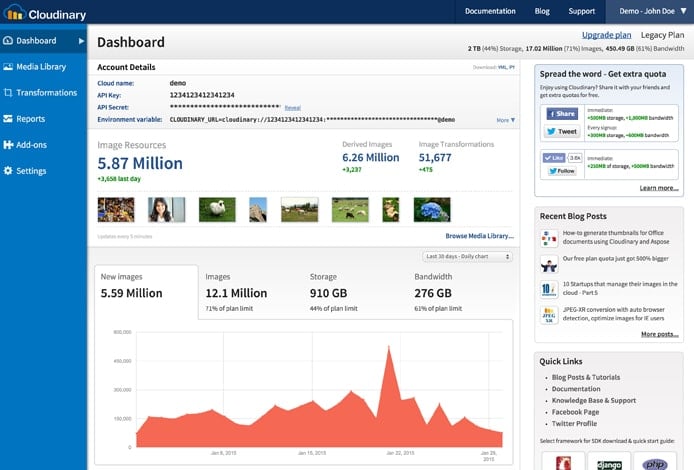
TL; DR: Since its founding in 2011, Cloudinary has been providing companies of all sizes with cloud-based image management services that optimize their development pipelines and help them quickly deliver web apps to market. Through an end-to-end solution built for and by developers, Cloudinary is able to boost web app performance, which results in better SEO and customer engagement rates that ultimately lead to healthier profits. As marketing departments start to use the platform to personalize messaging and content delivery, Cloudinary is positioned to help businesses improve user experiences and reduce operational costs well into the future.
As one of India’s largest online tours and activities platforms, Thrillophilia’s online applications give adventure seekers a means to discover opportunities to launch exciting expeditions around Asia. These tourists are looking to trek through exotic locations they’ve never visited, and one way to attract their business is through compelling imagery of the natural landscapes not present in their home locales.
As a result, Thrillophilia’s platform must support more than 1 million images with upward of 250,000 unique graphics spread over 200,000 pages for the company’s 10,000 activities. Thrillophilia depends on their suppliers to upload the raw format of these images; however, since these photos aren’t always the photogenic graphics the company desired, Thrillophilia needed an effective way to manage and edit them.
“We needed a robust solution to manage our images and deliver them quickly to our visitors,” said Abhishek Daga, Thrillophilia’s Co-Founder. “More importantly, to ensure the integrity of our graphics, we needed an efficient means to enhance all images to make them look beautiful.”
That’s when Thrillophilia turned to Cloudinary for help. According to Abhishek, Cloudinary’s cloud-based image management platform enabled Thrillophilia to enhance original images, resize them, and quickly deliver them to optimize the overall experience of the end user.

Cloudinary helps businesses optimize their dev pipelines through cloud-based image management.
“There was a significant difference in page load speeds after we started using Cloudinary,” Abhishek said. “And by combining JPEGmini and Viesus, we were able to reduce the page size without compromising on image size.”
This cut the 4TB per month Thrillophilia was serving in half and saved tremendously on storage and bandwidth overhead.
According to Robert Moseley, Cloudinary’s Senior Solutions Engineer, challenges, like Thrillophilia’s, are quite common.
“Images are 65% of all web management,” he said. “Whether you’re a small site or a large site, you need to put a pipeline together.”
Since 2011, Cloudinary has been helping organizations large and small optimize these development pipelines with its end-to-end image solution built specifically for developers. The company’s platform is an ideal vehicle to ease media-related R&D work, scale web apps and products, and significantly lower IT and operational costs.
An End-to-End Image Solution Built by Developers for Developers
Cloudinary has helped more than 200,000 companies — from small blogs and startups to large enterprises — manage development processes. In 2011, Cloudinary’s Founders, 20-year veterans in website development for startups, found themselves frustrated with a lack of options to effectively process images.
“Images don’t flow well; they’re like objects,” Robert said.
This fact led Cloudinary’s Founders to streamline the process by creating their own API-based pipeline. Robert told us the Founders discovered that other developers were seeking the same solution, and the platform took off.
Though various caching plugins, content delivery networks (CDNs), and frontend optimization services exist for similar purposes, they’re rarely comprehensive.
“There are all kinds of microservices,” Robert said. “If you really want to build full optimization across every level of the pipeline, you have to invest in several different services and integrate them together into a single pipeline and hope that everything is scalable and that everything works. It becomes this really complex, convoluted process.”
Companies that depend on pieced-together systems composed by one individual are especially at risk. Robert noted problems sometimes arise when developers who build systems at large organizations move on to other positions. When their replacements come in, the systems become difficult to maintain. Cloudinary, on the other hand, zeroes in on the full picture.
“What really differentiates us is we optimize the entire workflow — the entire pipeline — all the way from uploading the assets to delivering it through a CDN,” Robert said. “And we make sure that all the parts in between are accounted for.”
It’s a concept that is gaining more and more industry attention.
“It’s kind of like when the first guy ran the four-minute mile. No one had ever done it before, but as soon as he did it, a ton of people could run a four-minute mile for whatever reason,” Robert said. “Now, we see people realizing that this is a problem that can be addressed.”
Robert acknowledged big players in the industry, such as Akamai and Adobe, are now coming out with similar solutions. However, he was quick to point out that Cloudinary pioneered the space and is way ahead of the game.
“We started first, so we have a ton of market advantage because of that,” Robert said. “We are the best solution.”
Optimize the Entire Pipeline From Upload to Global CDN Delivery
Cloudinary’s platform includes a full spectrum of services, from uploads, storage, and administration to manipulation, optimization, and delivery. These services free customers from unnecessary R&D work, improve user experience, reduce IT costs, and provide cutting-edge image capabilities.
“We have all the bases covered,” Robert said.
Users can upload images of any format to the cloud, from any source, and at any scale — from one or two files to millions. Files are stored in the cloud, with revision tracking and automatic backup included. On the administrative side, users receive reports and analytics through a web-based management console as well as an online web interface for managing media on the go.
When it comes to manipulating images, Cloudinary offers a selection of capabilities, including resizing, cropping, adding text overlays and watermarks, and more. The system also offers automatic image size and quality optimizations with images delivered through a global CDN that pulls from multiple sources.
While Cloudinary provides users full capability to make manual adjustments, Robert said that “the power is in the automatic stuff. If you have to select what format you want for each one, that’s a bottleneck; something that you have to do — and the whole idea is to make everything automatic.”
Boost Web App Performance, SEO, Customer Engagement, and Revenue
Beyond automation, Robert said increased performance is a side effect of the service. It’s well-known that increased web app performance improves SEO and customer engagement rates — and, in turn, influences a company’s financial health.
According to a September 2016 Google study, more than half of visitors abandon mobile sites after a loading period of three seconds. The study also found a positive relationship between page speed and revenue, with mobile sites that load in five seconds earning twice as much in ad revenue than those that load in 19 seconds.
“The benefits are obvious — they are well-studied,” Robert said. “It’s not a hypothesis; it’s a well-established effect.”

Cloudinary helps boost web app performance, which results in better user experiences and happier bottom lines.
Robert noted that better performance also has an effect on getting customers to the website in the first place, citing Facebook’s recent decision to place sites with shorter load times higher in its news feed. And the effect of performance on data analytics should also be considered.
“If your webpage takes 10 seconds to load, most of the time your analytics tags are firing at the bottom of the page at document ready,” Robert said. “If that happens, there are probably plenty of your visitors that either abandoned before 10 seconds or clicked on to the next page, and you have no way of tracking whether they were there.”
Cutting that time down to five seconds, according to Robert, can have a dramatic impact on data quality, which will allow site owners to optimize their marketing efforts. To help customers gauge key performance measures of their sites, Cloudinary recently introduced Website Speed Test, an image analysis feature developed through a partnership with webpagetest.org.
Using the free tool, customers can perform speed tests based on various locations, browsers, and connections. The site also includes detailed insight on the optimization benefits Cloudinary can provide, including estimated megabyte savings.
New Use Case: Scale A/B Testing and Content Personalization
Though Cloudinary is primarily focused on developers and will always be “developer first,” Robert has observed marketing departments using the service to help scale A/B testing — a digital marketing technique that compares two variations of a webpage. This also helps marketing teams customize experiences through personalization.
“We’ve found a lot of marketing organizations — especially the ones that are ahead of the game — adopting Cloudinary to do some really cool things,” Robert said.
Robert told us that personalizing marketing messages is like the Holy Grail to modern marketers. Businesses want their audiences to feel like they’re being spoken to directly and not just being bombarded with mass-marketing content. And Cloudinary’s platform is solving this problem.
“Personalization has been thrown around a lot, but no one has really executed on it extremely well yet,” he said. “Now we’re starting to see people using Cloudinary in clever ways to lift that burden, remove that bottleneck, and scale out personalization efforts by dynamically generating content.”
HostingAdvice.com is a free online resource that offers valuable content and comparison services to users. To keep this resource 100% free, we receive compensation from many of the offers listed on the site. Along with key review factors, this compensation may impact how and where products appear across the site (including, for example, the order in which they appear). HostingAdvice.com does not include the entire universe of available offers. Editorial opinions expressed on the site are strictly our own and are not provided, endorsed, or approved by advertisers.
Our site is committed to publishing independent, accurate content guided by strict editorial guidelines. Before articles and reviews are published on our site, they undergo a thorough review process performed by a team of independent editors and subject-matter experts to ensure the content’s accuracy, timeliness, and impartiality. Our editorial team is separate and independent of our site’s advertisers, and the opinions they express on our site are their own. To read more about our team members and their editorial backgrounds, please visit our site’s About page.

